
Halemweg is a station on the Berlin U-Bahn line U7, located in the Charlottenburg-Nord district. It was opened on 1 October 1980 with the line's extension from Richard-Wagner-Platz to Rohrdamm. The eponymous neighborhood street is named after Resistance fighter Nikolaus von Halem, who was executed in Brandenburg-Görden Prison on 9 October 1944. The next station is Jakob-Kaiser-Platz.
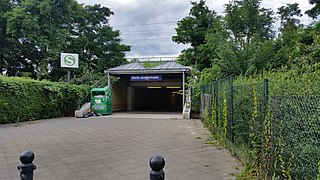
Berlin Jungfernheide is a railway station located at Charlottenburg-Nord, in the Charlottenburg-Wilmersdorf district of Berlin, served by the S-Bahn lines and , the U-Bahn line and Regional-Express trains of the Deutsche Bahn. Its name literally translates into "maidens' heathland"; it was named after the Jungfernheide, a former large forest in the proximity of this station.

Mierendorffplatz is a station on the Berlin U-Bahn line in Charlottenburg. It was opened on 1 October 1980 with the line's extension from Richard-Wagner-Platz to Rohrdamm. The eponymous square is named after politician and Resistance fighter Carlo Mierendorff (1897–1943). Architect Rümmler designed this station walls like the pattern of a M as in Mierendorffplatz. The next station is Richard Wagner Platz.
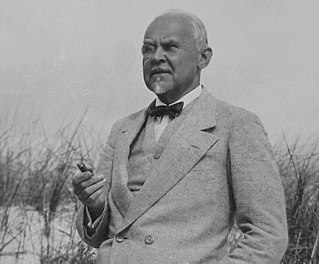
Alfred Frederik Elias Grenander was a Swedish architect, who became one of the most prominent engineers during the first building period of the Berlin U-Bahn network in the early twentieth century.
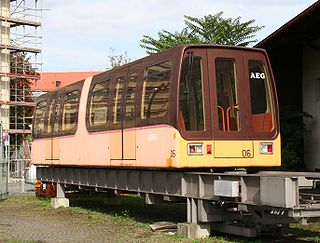
The M-Bahn or Magnetbahn was an elevated Maglev train line operating in Berlin, Germany, experimentally from 1984 and in passenger operation from 1989 to 1991. The line was 1.6 kilometres (1 mi) in length, and featured three stations, two of which were newly constructed. Presumed to be the future of rail transit in Berlin, the line was built to fill a gap in the West Berlin public transport network created by the construction of the Berlin Wall. It was rendered redundant by the reunification of Berlin and was closed to enable reconstruction of the U2 line.

Berlin Heidelberger Platz is a railway station in the Wilmersdorf district of Berlin. It is served by S-Bahn lines , and and U-Bahn line .
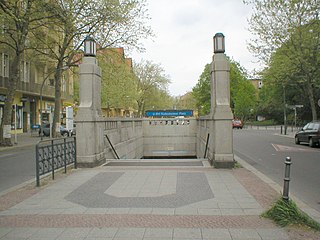
Rüdesheimer Platz is a Berlin U-Bahn station located in the Wilmersdorf district on the line.

Bayerischer Platz is a Berlin U-Bahn station on the and the lines. The station is located under the square of the same name in the centre of the Bayerisches Viertel neighbourhood in Schöneberg. The U4 station opened with the rest of the line on 1 December 1910 and is now a protected historic landmark; the U7 part of the station opened on 29 January 1971.

Kurt-Schumacher-Platz is a station on the line of the Berlin U-Bahn. There had been a bus link outside the station connecting Berlin's Tegel International Airport to the U-Bahn network. The station was opened on 3 May 1956 and named after famous German politician Kurt Schumacher.

Cottbusser Platz is a Berlin U-Bahn station located in the borough Marzahn-Hellersdorf on the line.

Platz der Luftbrücke is a Berlin U-Bahn station located on the . It is located under Platz der Luftbrücke and the south end of Mehringdamm on the border between Kreuzberg and Tempelhof, near the former Tempelhof International Airport, and is now named for the square there with its memorial to the victims of the Berlin Airlift.

Konstanzer Straße is a Berlin U-Bahn station located on line in the Wilmersdorf district.

Friedrich-Wilhelm-Platz is a Berlin U-Bahn station located on the . It opened for service in 1971.

Walther-Schreiber-Platz is a Berlin U-Bahn station located on the line in Steglitz-Zehlendorf. Built from 1967 to 1969, the station is located completely under the Bundesallee, which flows into Walther-Schreiber-Platz. The station was opened on 29 January 1971, and until September 1974 was the southern terminus of the former Line 9.

Mitte is a central locality of Berlin in the eponymous district of Mitte. Until 2001, it was itself an autonomous district.
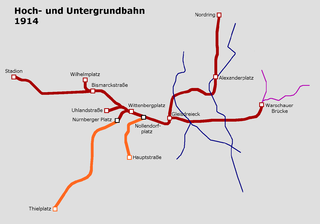
Nürnberger Platz was a Berlin U-Bahn station on what is now the , located under the square of the same name in Wilmersdorf on the border with Charlottenburg. The station opened on 12 October 1913 and was permanently closed on 1 June 1959.
The U11 line is a planned line of the Berlin U-Bahn.

The Berlin U-Bahn originated in 1880 with Werner Siemens' idea to build an urban railway in Berlin. During the nine years after the German Empire was founded, the city's population grew by over one-third and traffic problems increased. In 1896, Siemens & Halske began to construct the first stretch of overhead railway. On 1 April 1897, the company began construction of an electric underground railway. The Berliner Verkehrs Aktiengesellschaft (BVG) was formed in 1928, and took over further construction and operation of the network. In 1938, the company was renamed Berlin Transport Company; the original acronym, however, remained. Since 1994, the BVG has been a public company.
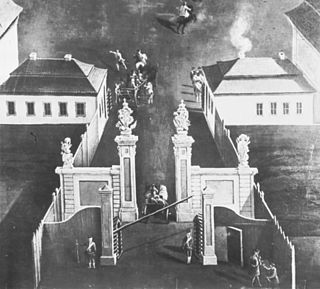
The Hallesches Tor was located in today's Berlin district Kreuzberg south of Mehringplatz. Today, as a historic monument listed underground station on the site of the former gate bears the name Hallesches Tor. It is a major transfer point for the underground lines / and as well as the bus lines 248 and M41. The station is connected by the Hallesche-Tor-Brücke with the Blücherplatz to the south. The Amerika-Gedenkbibliothek and the nearby Jewish Museum contribute to the heavy visitor traffic in the area around the Hallesches Tor.

Rosenthaler Platz in Berlin's Mitte district, district Mitte, forms a crossroads where Rosenthaler Strasse, Brunnenstrasse and Weinbergsweg meet Torstrasse, and is therefore not a square in the true sense of the word. It is located on the site of the former Rosenthaler Tor of the Berlin customs wall, from which a road led to the village of Rosenthal. This gate was one of the few through which Jews were allowed to enter Berlin until the 19th century. Those who were not allowed to enter could stay overnight in a special Jewish hostel.

![]() . Opened in 1930, the station was designed by Alfred Grenander, making prominent use of orange uranium tiles. [1] [2]
. Opened in 1930, the station was designed by Alfred Grenander, making prominent use of orange uranium tiles. [1] [2] 

















